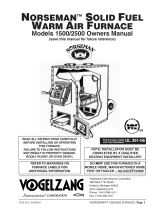FIELD CONTROLS DR is a draft regulator designed to be used with oil or solid fuel burners, helping maintain optimal draft and improving fuel efficiency. It can be used to enhance the performance of domestic oil burners (recommended draft: 0.01 to 0.02 inches W.C.) and solid fuel burners (recommended draft: 0.04 to 0.08 inches W.C.). Additionally, the FIELD CONTROLS DR can aid in eliminating smokey fires and pulsation caused by excessively high draft settings.
FIELD CONTROLS DR is a draft regulator designed to be used with oil or solid fuel burners, helping maintain optimal draft and improving fuel efficiency. It can be used to enhance the performance of domestic oil burners (recommended draft: 0.01 to 0.02 inches W.C.) and solid fuel burners (recommended draft: 0.04 to 0.08 inches W.C.). Additionally, the FIELD CONTROLS DR can aid in eliminating smokey fires and pulsation caused by excessively high draft settings.



-
 1
1
-
 2
2
-
 3
3
FIELD CONTROLS DR Installation guide
- Type
- Installation guide
- This manual is also suitable for
FIELD CONTROLS DR is a draft regulator designed to be used with oil or solid fuel burners, helping maintain optimal draft and improving fuel efficiency. It can be used to enhance the performance of domestic oil burners (recommended draft: 0.01 to 0.02 inches W.C.) and solid fuel burners (recommended draft: 0.04 to 0.08 inches W.C.). Additionally, the FIELD CONTROLS DR can aid in eliminating smokey fires and pulsation caused by excessively high draft settings.
Ask a question and I''ll find the answer in the document
Finding information in a document is now easier with AI
Related papers
Other documents
-
Vermont Casting 2547CE User manual
-
Vermont Casting 2550CE User manual
-
 Vogelzang International NORSEMANTM SOlid FuEl WARM AiR FuRNAcE 2500 User manual
Vogelzang International NORSEMANTM SOlid FuEl WARM AiR FuRNAcE 2500 User manual
-
Vermont Casting Stove 1450 User manual
-
DutchWest 2461 Installation guide
-
DutchWest 2461 Installation guide
-
Vermont Casting 2550 User manual
-
Vermont Casting 1990CE User manual
-
 Vogelzang International VG2500 Installation guide
Vogelzang International VG2500 Installation guide
-
DutchWest 2461 Operating instructions




